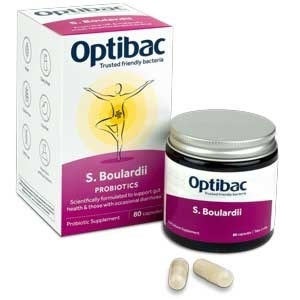Probiotics and Small Intestinal Bacterial Overgrowth (SIBO)
Small intestinal bacterial overgrowth is increasingly recognised as a cause of abdominal bloating, pain and diarrhoea. Historically believed to afflict only those who had structural abnormalities of the gastrointestinal tract1, it is actually an increasingly common cause of digestive symptoms: up to 78% of individuals with irritable bowel syndrome, one of the most widespread gastrointestinal complaints worldwide, have been found to have SIBO on breath testing.2
In this article we will cover:
- What is SIBO?
- What causes SIBO?
- What are the symptoms of SIBO?
- How is SIBO diagnosed?
- What is the best treatment for SIBO?
- Are probiotics good for SIBO?
- Which are the best probiotics for SIBO?
- SIBO Checklist

What is SIBO?
Small Intestinal Bacterial Overgrowth, or SIBO, is the excessive growth of bacteria in the small intestine. The small intestine usually is colonised by some bacteria but much less than the large intestine. When there is an abnormally high quantity of bacteria in the small intestine, there is increased bacterial fermentation of food as it enters from the stomach. This results in increased gas production, usually hydrogen and sometimes methane gases. Those with predominantly hydrogen-producing bacteria typically suffer from diarrhoea, SIBO-D, and those with predominantly methane-producing bacteria may experience constipation symptoms, SIBO-C. As high hydrogen levels can also indicate lactose intolerance, it is important to determine the underlying cause of your symptoms.
In the short term, increased gas production can lead to bloating, flatulence, nausea and abdominal pain. Long term, bacterial overgrowth can lead to local intestinal mucosal inflammation. This can damage the lining of the intestinal tract, flattening villi and thinning the mucosa which can in turn, prevent optimal absorption of nutrients, in some cases leading to vitamin and mineral deficiencies.
You may be wondering about the difference between SIBO and SIFO (Small Intestinal Fungal Overgrowth). Well, SIBO is much alike SIFO, except that there is an overgrowth of pathogenic bacteria, such as Streptococcus, Enterococcus, Klebsiella and E. coli. whereas the latter conditions is a fungal overgrowth. SIFO has been shown to be caused primarily by Candida Albicans.15 However, both types present with excess methanogenic archeas in the GI tract. The correct term from this is IMO, also known as methane-producing microbes.16
We are sometimes asked if it is possible to have SIBO and SIFO at the same time. This is possible but both conditions have a similar presentation so it may be hard to determine which one you have unless you test. A study testing for SIBO and SIFO showed that 32 patients out of 150 had both conditions, showing that it may not be a common occurrence.
What causes SIBO?
SIBO can have a number of causes, and it is important to understand the cause to be able to choose the most appropriate treatment. The causes can be:
- Reduced gastric secretion
- Medications including PPI’s and opiates
- Part of the natural aging process
- Antibiotic use
- Ileocaecal valve dysfunction
- Impaired intestinal mobility
- Structural changes, for example, following gastric surgery
- Irritable Bowel Syndrome - there is a significant association between IBS-D and SIBO17
- Crohn's Disease
- Coeliac Disease
- Systemic diseases such as Diabetes Mellitus, systemic sclerosis, liver disease
The two most common causes of SIBO are reduced gastric acid secretion and impaired small intestinal motility3. Stomach acid inhibits the growth of bacteria that is ingested in our food. Normal intestinal motility keeps the contents of our small intestine moving and prevents stasis of food and bacteria, which can lead to bacterial overgrowth.
Recurrent or long-term antibiotic use is also a risk factor for the development of SIBO. Antibiotics can alter the composition of bacteria in the small intestine leading to increased growth of pathogenic bacteria. For more about antibiotics and the microbiome, take a look at this article in the Probiotics Learning Lab: Probiotics and Antibiotics.
Poor function of the the ileocaecal valve, located at the junction between the ileum (small intestine) and the caecum (start of the large intestine), is also a risk factor for SIBO. This valve prevents the “backflow” of colonic contents from re-entering the small intestine, but individuals with a dysfunctional ileocaecal valve are at increased risk of developing SIBO as colonic bacteria can enter and colonise the small intestine more easily4.
Individuals with immune deficiencies, such as with HIV, are also prone to bacterial overgrowth.
What are the symptoms of SIBO?
Symptoms of SIBO may be related to the underlying cause of SIBO (low stomach acid, poor motility), the manifestation of SIBO itself, or the consequences of malabsorption. SIBO-C, typically associated with higher methane producing bacteria, presents with constipation whereas SIBO-D, typically associated with hydrogen producing bacteria, presents with diarrhoea but other common symptoms include:
- Nausea
- Bloating
- Abdominal distension
- Flatulence
- Abdominal pain and cramping
- Diarrhoea (less commonly, constipation)
- Fatigue or poor concentration5
Signs of corresponding malabsorption could include:
- Bulky, difficult to flush stool with high fat content due to fat malabsorption (known as steatorrhoea)
- Weight loss
- Anaemia
- Deficiency of vitamin B12 or fat-soluble vitamins A, D, E, K5
How is SIBO diagnosed?
SIBO is typically diagnosed based on patient history, followed by a diagnostic test. Healthy individuals have less than 103 CFU (or colony forming units) of bacteria per millilitre of digestive fluid in the small intestine. There are currently two diagnostic tests used for SIBO:
- Jejunal aspiration - a direct measurement of the numbers of bacteria in the small intestine
- Breath test - an indirect measurement of the bacteria numbers, gleaned from the measurement of the by-products of their fermentation activity.
Small bowel aspiration and culture
SIBO can be diagnosed when there is greater than 103 CFU of bacteria cultured per mL of digestive fluids from the small intestine. This aspiration can be performed on endoscopy, but it is not routinely practised as it is time consuming and expensive, and is an invasive procedure with some risk attached to performing it.
Breath Test
Hydrogen gas is produced by bacteria in the gastrointestinal tract as a by-product of fermentation of simple carbohydrates. During this diagnostic test, glucose or another simple carbohydrate is given to a patient, and the hydrogen and methane* gases exhaled in their breath over the following 90 minutes, is measured. This is under the premise that hydrogen is rapidly produced by bacterial fermentation in the small intestine. The gases are absorbed into the bloodstream and excreted in the breath. A rise of 20ppm in exhaled hydrogen above baseline within 90 minutes of oral ingestion of 75g of glucose is considered diagnostic. There are many benefits with this type of testing including its wide availability, it is inexpensive, non-invasive and technically easy to perform. However, there is an increased risk of false positives as some individuals have faster colonic transit, and hydrogen may be produced in the colon. It is also relatively poor at diagnosing SIBO in the distal small intestine (the furthest end of the small intestine) as glucose is absorbed proximally (in the nearest end). Meaning that the glucose may not reach the distal small intestine and trigger bacterial fermentation here.
*Human cells are incapable of producing hydrogen and methane gases. Although methane is not produced by bacteria, the archaea that produce it use hydrogen as a substrate so its presence suggests increased hydrogen production. A rise of greater than 10 ppm of methane is diagnostic of methanogenic archaea overgrowth.

What is the best treatment for SIBO?
There are three areas to address when managing SIBO:
- The underlying cause of SIBO
- Malabsorption and nutritional deficiencies
- The bacterial overgrowth itself with antibiotics.
As discussed above, there are various underlying causes of SIBO. Medication use can be reviewed and potentially stopped, such as proton pump inhibitors and opiates, under the guidance of a healthcare practitioner. Avoiding fermentable carbohydrates such as in the low FODMAP diet can reduce bacterial fermentation in SIBO and could be considered, again under the guidance of a healthcare practitioner6. Managing IBS requires an individualised approach - you can read more about this in our article on remedies for IBS.
Addressing nutritional deficiencies is very important. Vitamin B12 and fat-soluble vitamins A, D, E and K may need to be supplemented. Damage to the lining of the intestinal tract can also prevent enzyme production which may require supplementation with digestive enzymes3.
Although there is no universally accepted standardised treatment for SIBO, the mainstay of treatment of SIBO currently is with antibiotics to reduce bacterial colonisation in the small intestine5. R*******n is the best studied antibiotic for this purpose as it has poor systemic bioavailability which means that it mostly works locally in the gastrointestinal tract7. The British Society of Gastroenterology use 550mg of r*******n twice daily for 7 days in those with abnormal breath tests8. Often SIBO returns and more antibiotics are needed, this alongside increased knowledge of the consequences of overuse of antibiotics have seen the adoption of a more cautious approach with antibiotics.
Naturopathic protocols for SIBO include changes to diet, adopting a low-FODMAP diet in many cases, probiotics, herbal anti microbials and lifestyle changes. The most common approach is known as the ‘Five R’s’ protocol and at the appropriate stage, probiotics can be introduced.
Are probiotics good for SIBO?
Saccharomyces boulardii has a number of modes of action that can be helpful in SIBO. As part of a 'Five R's' protocol, its antimicrobial properties can be used to inhibit the growth of pathogenic bacteria and remove them from the gut whilst soothing an inflamed gut by restoring levels of SCFA’s and stimulating the production of anti-inflammatory molecules14. Soil based probiotics have been shown to reduce symptoms of SIBO and prevent it from coming back which is a common occurrence, although further research is needed, one hypothesis is that it is because they don’t colonise in the small intestine and possess anti-inflammatory properties10.
Which are the best probiotics for SIBO?
As healthcare professionals we get asked a wide variety of questions about SIBO. The main question being, are probiotics bad for SIBO? Or, conversely, which probiotic is best for SIBO? And more recently, a new question, which are the best soil based probiotics for SIBO. Let’s look at the best probiotic strains for SIBO.
Although it may be seen as contradictory to use probiotics in small intestinal bacterial overgrowth, one particular probiotic yeast, Saccharomyces boulardii, which is a probiotic yeast, and soil-based probiotics have been identified as beneficial. Let’s look at how Saccharomyces boulardii and soil based probiotics might help with SIBO. Could either of these be the best probiotic for SIBO?

Saccharomyces boulardii can be found in Optibac Probiotics S. boulardii
As a yeast, Saccharomyces boulardii can be taken alongside antibiotics and its functioning is unaffected. It has known anti-inflammatory effects in the gut9 and can inactivate pathogenic toxins10 and stimulate enterocyte (cells of the intestinal lining) maturation11.
In a pilot clinical study of 40 patients diagnosed with SIBO due to the autoimmune condition, systemic sclerosis, the effects of Saccharomyces boulardii on hydrogen production and SIBO eradication was assessed and compared with m***********e, a common antibiotic used in the treatment of SIBO12. The patients were divided into 3 groups; one group were given m***********e alone for 1 week, another group were given m***********e with Saccharomyces boulardii for 1 week and the third group were given Saccharomyces boulardii alone for 1 week. Two months later, hydrogen breath tests were repeated. The group that achieved the best results was the m***********e and Saccharomyces boulardii group, with SIBO eradicated in 55% of participants at 2 months. Saccharomyces boulardii therapy alone eradicated 33% which was better than the group given m***********e alone (with just 25% SIBO eradication). Of note, the Saccharomyces boulardii group had the lowest level of adverse effects from treatment, and taking SB alongside m***********e appeared to reduce the risk of antibiotic side-effects from 53% to 36%12. The results of this clinical study suggest Saccharomyces boulardii as a potential beneficial adjunct to antibiotic therapy when treating SIBO.
Interestingly, soil based probiotics have shown promise in SIBO. A small gold standard trial investigated B. coagulans Unique IS-2 in 30 individuals with chronic abdominal pain or diarrhoea and a positive hydrogen breath test (HBT), SIBO-D. All participants underwent three weeks of antibiotic therapy (using broad spectrum antibiotics). The individuals were then randomised to receive either B. coagulans Unique IS-2 or a placebo daily for 15 days alongside a maintenance antibiotic dose. After six months, GI symptoms and HBT’s were analysed. In the probiotic group, GI symptoms including belching, flatulence and diarrhoea had all significantly improved and abdominal pain had disappeared completely. HBT’s turned negative in 93% of individuals in the probiotic group compared with 67% in the placebo group13
SIBO Checklist
- Small Intestinal Bacterial Overgrowth is the excessive growth of bacteria in the small intestine, where there is usually minimal bacterial colonisation.
- In the presence of symptoms and risk factors for SIBO, clinical diagnosis usually involves a hydrogen breath test.
- The symptoms of SIBO are due to the gas produced by bacterial fermentation of carbohydrates, and the local inflammation caused by the presence of excessive bacteria in the small intestine.
- There are two different types of SIBO: SIBO-D and SIBO-C.
- Common symptoms of SIBO include bloating, nausea, diarrhoea, indigestion and abdominal pain.
- SIBO is caused by factors that reduce gastric acid production or reduce small intestinal motility. Common causes include IBS, long term PPI use, recurrent or long-term antibiotic use.
- Along with addressing the underlying cause and nutritional deficiencies caused by SIBO, the mainstay of treatment is antibiotics.
- The diagnosis and management of SIBO should be carried out by a health care practitioner.
If you liked this article, read more about the research behind Saccharomyces boulardii over on our Probiotics Database.
References
- Krajicek EJ, Hansel SL. Small Intestinal Bacterial Overgrowth: A Primary Care Review. Mayo Clin Proc. 2016;91(12):1828-1833. doi:10.1016/j.mayocp.2016.07.025
- Shah ED, Basseri RJ, Chong K, Pimentel M. Abnormal breath testing in IBS: A meta-analysis. Dig Dis Sci. 2010;55(9):2441-2449. doi:10.1007/s10620-010-1276-4
- Dukowicz AC, Lacy BE, Levine GM. Small intestinal bacterial overgrowth: A comprehensive review. Gastroenterol Hepatol. 2007;3(2):112-122.
- Miller LS, Vegesna AK, Sampath AM, Prabhu S, Kotapati SK, Makipour K. Ileocecal valve dysfunction in small intestinal bacterial overgrowth: A pilot study. World J Gastroenterol. 2012;18(46):6801-6808. doi:10.3748/wjg.v18.i46.6801
- Pimentel M, Saad RJ, Long MD, Rao SSC. ACG Clinical Guideline: Small Intestinal Bacterial Overgrowth. Am J Gastroenterol. 2020;115(2):165-178. doi:10.14309/ajg.0000000000000501
- Adike A, DiBaise JK. Small Intestinal Bacterial Overgrowth: Nutritional Implications, Diagnosis, and Management. Gastroenterol Clin North Am. 2018;47(1):193-208. doi:10.1016/j.gtc.2017.09.008
- Shah SC. Meta-analysis: antibiotic therapy for small intestinal bacterial overgrowth. Aliment Pharmacol Ther. 2013;38(8):1-17. doi:10.1038/jid.2014.371
- Management of difficult-to-treat small-intestinal bacterial overgrowth | The British Society of Gastroenterology. https://www.bsg.org.uk/clinical-articles-list/management-of-difficult-to-treat-small-intestinal-bacterial-overgrowth-dr-andreyev-and-dr-poon-highlight-a-case-study-on-a-difficult-case-of-sibo/. Accessed April 22, 2020.
- Stier H, Bischoff SC. Influence of saccharomyces boulardii CNCM I-745 on the gut-associated immune system. Clin Exp Gastroenterol. 2016;9:269-279. doi:10.2147/CEG.S111003
- Tiago FCP, Martins FS, Souza ELS, et al. Adhesion to the yeast cell surface as a mechanism for trapping pathogenic bacteria by Saccharomyces probiotics. J Med Microbiol. 2012;61(PART 9):1194-1207. doi:10.1099/jmm.0.042283-0
- Moré MI, Vandenplas Y. Saccharomyces boulardii CNCM I-745 Improves Intestinal Enzyme Function: A Trophic Effects Review. Clin Med Insights Gastroenterol. 2018;11. doi:10.1177/1179552217752679
- García-Collinot G, Madrigal-Santillán EO, Martínez-Bencomo MA, et al. Effectiveness of Saccharomyces boulardii and Metronidazole for Small Intestinal Bacterial Overgrowth in Systemic Sclerosis. Dig Dis Sci. 2020;65(4):1134-1143. doi:10.1007/s10620-019-05830-0
- Khanbhai, A. and Singh Sura, D. (2013) ‘Irritable bowel syndrome for primary care physicians’, British Journal of Medical Practitioners , 6(1), pp. a608-undefined.
- Kelesidis T, Pothoulakis C. Efficacy and safety of the probiotic Saccharomyces boulardii for the prevention and therapy of gastrointestinal disorders. Therap Adv Gastroenterol. 2012 Mar;5(2):111-25. doi: 10.1177/1756283X11428502. PMID: 22423260; PMCID: PMC3296087.
- Winnie-Pui-Pui Liew, Sabran Mohd-Redzwan. (2018). Mycotoxin: Its Impact on Gut Health and Microbiota. Frontiers in Cellular and Infection Microbiology. 8(60), pp.1-17. (Ed). Handbook of Gastrointestinal Motility and Disorders of Gut-Brain Interactions. 2nd ed. USA: Academic Press. pp.205-221.
- Michalina Banaszak,,Ilona Górna,,Dagmara Woźniak. (2023). Association between Gut Dysbiosis and the Occurrence of SIBO, LIBO, SIFO and IMO. Microorganisms. 11(3), pp.1-15.
- Chuah KH. et al., (2023) Impact of small intestinal bacterial overgrowth on symptoms and quality of life in irritable bowel syndrome. Journal of Digestive Diseases, 24(3):194-202. doi: 10.1111/1751-2980.13189. Epub 2023 Jun 8.
Popular Articles
View all Digestive Health articles-
Digestive Health09 Feb 2024
-
Digestive Health12 Jul 2023


